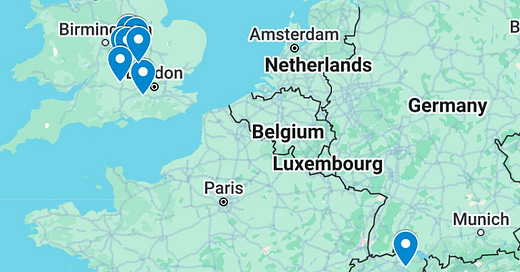Before we begin, let me clarify that title in a footnote. If you already get the reference, read on here.1
Writing today from London, I thought we need a British post. So, here is one, introduced with a quiz: where are most Formula 12 cars built? (I refer to the chassis, etc., not to the engines.) Since I pretty much gave this away already, no points for a correct answer: it is the UK, and specifically, England, in so-called Motorsport Valley (though I personally have never heard that phrase used). Of the ten teams I know of (Alpine, Aston Martin, Haas, McLaren, MB, Red Bull, Williams, Ferrari, Sauber, and RB), the first 7 are all made in the UK. Here’s the chart map:
I won’t go into the explanation for how this happened, there are books and reports you can read on the topic, but I think most people would agree it was first a matter of historical accident, that then evolved into a deliberately and actively sustained success through the formation of a close-knit “cluster” ecosystem of suppliers, research institutions, workforces, and more. At this point it is hard to see how another region could break up this dominance (just as various locations in the USA have had limited (though some) success displacing Silicon Valley as the IT hub)3.
(At this point in the story someone inevitably brings up the Bad Old Days of British Leyland and makes a crack along the lines of: “Britain: we’re brilliant when we only have to make 100 cars a year, rubbish if we try to make 100,000.” Ahem. Let’s move on.)
So, congratulations to Motorsports Valley, and your leadership in high-speed car production!
(Though, walking through London today, and seeing more than a few UHNWI’s idling their Lambos and Ferraris through the notoriously slow traffic, I have to say never have I seen more TWO-HUNDRED-mph machines being driven at FIVE mph, than here! Today I “outwalked” a McLaren for a couple of blocks.)
And now a second quiz, which I won’t ruin with a spoiler. In what country are ALL the chassis (specifically, monocoque + suspension) used in the Indianapolis 500 made?4 It ain’t ‘Murica!
But whatever you do, don’t tell You Know Who the answer, or the Indy 500 may be “tariffed” out of existence this spring!
The immortal poet William Blake wrote in 1804-1810 or so an epic called Milton: A Poem in Two Books. In the preface to the book is found a poem by Blake called And did those feet in ancient time, whose full text is here. The poem was set to music by Sir Hubert Parry in 1916, as the hymn Jerusalem, but is almost always performed with orchestration written in 1922, by Sir Edward Elgar. Are you following all this? This beloved hymn has been mined for phrases that are now fully embedded in Anglophone culture, from “dark Satanic Mills” to “Englands [sic] green and pleasant Land” and, finally, to “Bring me my Chariot of Fire.” (See 2 Kings in the Old Testament.) I tell you all this to explain my title, which links together England (green and pleasant land) and Formula 1 (chariots of fire). And also to head off fans of the fantastic movie Chariots of Fire (1981), who might carp that the line should be in the plural, not the singular. Well, in the movie title, yes — but sorry: in the original it is just one Chariot.
For everyone outside the USA, you know what Formula 1 is. For my American readers, Formula 1 is a motor-racing series that was spun off from a Netflix docu-drama called Drive to Survive. Drive to Survive itself is primarily centered around intense audience speculation as to how many F-bombs Günther Steiner can insert in any given interview. My personal favorite, regarding a driver Steiner thought was not quite on the pace: “He’s worried about overheating the brakes? F*****g hell! He’s going so f*****g slow he doesn’t need a brake!”
Anyone remember “Silicon Beach”? Look it up!
Yes, gearheads, I know they have a Stateside engineering and production facility, to support teams in the USA, but I am asking about the mother ship here.




